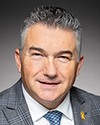I can, absolutely. I have the pleasure of managing our military assistance program to Ukraine. I'm very proud of the work that we've done with some of those armoured vehicles that members have referred to that are no longer usable.
It's an incredibly challenging space for the Ukrainians. There are, as we already alluded to, significant upticks in ballistic missile attacks and drone attacks. When we speak to the Ukrainians, they've underlined to us consistently the need for more investments in air defence, the need for more investments in artillery shells and the need for more investment in drones.
Canada has played a proud part in that. We have recently announced a contribution to a U.S.-NATO initiative, the Prioritised Ukraine Requirements List, which provides urgently needed high-end military equipment to the Ukrainians, including things like Patriot missiles. We've also been able to make significant investments from Canadian industry to support the work that Ukraine is doing, not only through components but also things like armoured vehicles, ammunition and other supports.
The work we do is helping Ukraine on the ground every day. We are always keen to do more, but we recognize the need to make sure that the investments we are making are worthwhile and relevant for Canada and for Ukraine.




